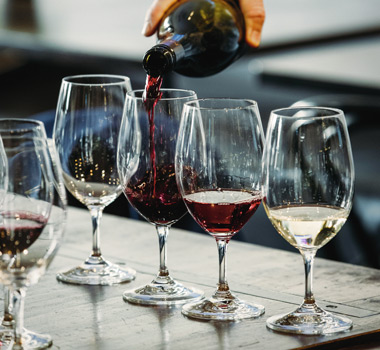
Wine
McWilliam's: Dream Vertical
It’s impossible to overstate the influence the McWilliam family has had on Australia’s wine story. They pioneered Griffith as a wine region and invested in Maurice O’Shea, who shaped the Hunter’s wine identity. At the beginning of the 20th century, their branding, production and logistics were trailblazing and they helped transform the market from fortified to table wines.
Now, a new chapter is forming and while they have been working on it for some time, the stars are aligning and it’s clear the future is all about the best of their backyard: New South Wales.
Cool Flavour
.jpg?lang=en-AU)

The tasting, hosted by McWilliam’s Chair and ex-Chief Winemaker Jim Brayne, Group Chief Winemaker Jim Chatto and Marketing GM Sarah Nichols, began with the McW Reserve 660 range of wines that are made in Hilltops and Tumbarumba.
“We are really celebrating the best of cool climate viticulture in NSW and altitude is the key,” Jim Chatto explained.
“The idea is to make contemporary wines with labels that express their altitude,” Sarah added. “We want these wines to come with a sense of discovery.”
The effect of altitude – warm days, cool nights and a long ripening period – was immediately evident. The wine was light and fresh with a pleasant wash of apples and white stone fruits finishing with a creamy, nutty zing.
“Tumbarumba Chardonnay is quite different from anywhere else in Australia,” Jim C remarked. “Purity is an important part of the style, I love its structure, power and minerality, it’s reminiscent of great old world Burgundy flavours and that’s exciting.”
The 2018 660 Reserve Pinot was next with cherry and blueberry aromatics linking to a palate of fine and crunchy red cherries and black cherry flavours. Soft and supple, this wine indicated a good future for Tumbarumba Pinot Noir.
The 660 Reserve Hilltops Shiraz followed, showing dense but perfumed blue and black fruited aromas seasoned with spice and white pepper. The palate was packed with fresh, spicy black currants, liquorice, black cherries and fine tannins. One for the cellar, but with a poised, ‘drink now’ appeal.
Next, the 660 Reserve Hilltops Cabernet showed how bright a future there is for Cabernet in this region. “It’s my favourite variety for Hilltops,” Jim C said. “I like it as much as Margaret River Cabernet. You get a pure, black fruit expression and a structure with Hilltops fruit that’s impressive and exciting.”
The wine was fresh and expressive of fine black fruit aromatics blended with cassis, tomato bush and blackcurrants. The palate was full of its aromas, round and full, but restrained and elegant.
Single Sites


The single site wines pay further tribute to the notion that Chardonnay, Shiraz and Cabernet have exciting futures in Tumbarumba and Hilltops. The Johansen Vineyard Chardonnay was a classy wine with plenty of white peach, pears and nuts with a fine, tight palate displaying plenty of cellaring potential.
The Block K4 R2 Hilltops Shiraz followed and was aromatically lifted with a nuanced balance of sweet and savoury blue/black fruits, violets and spice. The palate was soft, round and complex with juicy layers of blueberries, blackberries, and cherries
The Block 19 and 20 Hilltops Cabernet rounded out the bracket and wowed the table with sweet fruited aromatics and an ethereal core of fleshy blackberries, cassis and chocolate. Jim Brayne expressed his belief that this wine comes from “the best blocks of Cabernet in NSW,” while Jim Chatto went further, noting this wine is “The best Cabernet we have ever made.”
Alternative Pathway
In searching for new flavours and varieties suited to a planet getting hotter, the family has launched a range that reflects a fresh alternative to the mainstream. The result is the McW Alternis range and consists of varieties that are gaining attention and traction in the market.
The 2017 Alternis Touriga, a Portuguese variety, is a round, soft and juicy wine with sweet sultana and chocolate aromas. Similarly slurpy was the delicious 2017 Alternis Nero d’Avola. Featuring a variety originating from the hot slopes of Sicily’s Mt Etna, this wine has appealing layers of inky black berries with a fine, juicy finish.
Ageing gracefully
Next we were treated to two wines that prove Tumbarumba Chardonnay has the ability to age beautifully beyond the 10-year mark. The 842 Tumbarumba Chardonnay 2014 showed white peach, apricot and white flower aromas backed up with concentrated, zippy lines of nectarines and creamy figs.
The 2006 Barwang 842 Chardonnay was delicious with its 13 years of development manifesting as a freshly baked apple turnover stuffed with cream and nuts, and a mouth-watering zip.
Fabulous Flagships
.jpg?lang=en-AU)
The special 1877 range followed, further illustrating the motivation for developing and showcasing NSW cool climate winemaking.
“We are thinking about the best fruit to represent McWilliam’s,” Jim Brayne remarked. “And Canberra and Hilltops are driving that for us.”
The 1877 Cabernet Shiraz 1999, a blend of Coonawarra Cabernet and Hilltops Shiraz, was ageing beautifully. Juicy red and black fruit aromas with a leathery perfume layer led to an elegant palate of sweet blackberries and blueberries. The fresh mouthfeel indicated 20+ years to go.
The 1877 Cabernet 2008, a multi-regional McLaren Vale-Hilltops blend, displayed power with lifted aromas of tomato leaf, cassis and chocolate. The bright, youthful palate reinforced the supreme age-ability of cool climate wines.
The next two wines were from Canberra and underscored how this region is going to be Australia’s next big thing for Shiraz. The 2015 1877 was exotically perfumed with spice, pepper and dark savoury fruits rounding out to a concentrated and elegant mouthful of blackfruits and fine satin tannins.
Then came the wine of the day, a yet to be released project wine that Chief Winemaker Andrew Higgins was tasked to make in 2018. “The brief was to make the best possible wine from NSW outside the Hunter” Jim Chatto explained.
Andrew chose fruit from Canberra and the result was stunning. Complex and elegant, the wine is yet to be named, but will sit nicely and deserves to be the McWilliam ‘icon’ within the range. The range will be the continuation of a journey which looks to pay homage to the past, but also demonstrates the high quality fruit and highly skilled winemaking.
A Fortified Future
Fittingly, we tasted two wines that pay homage to the heritage of the family and the building blocks upon which the business was built; a Tawny and a Muscat. Matured in French oak for 25 years, both wines were luscious and moreish and had the table questioning why Fortified wines aren’t more popular. A conclusion was not reached, but it was clear that the pioneering spirit of McWilliam’s is thriving and that the future of its wine story is going to taste as good as its past.